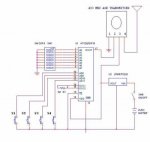I am more confused as you. In the AXE213pdf it talks about a test transmission and a receiving one.
In the test it has a line "serout txpin, n2400, ( “12345678” )"
So I being totally ignorant think that if it goes out like that then how do I get "12345678" back. If I knew how to do that then I could interrogate it in the Picaxe receiving end as being my data is there and not interference.
Hope that makes sense so far.
Now again in the documentation on the receiver test program it talks about seeing the received data in a led display. I dont have a display. I just want 1 variable containing "12345678".
The code lines "serin rxpin, n2400, b0, b1, b2, b3, b4, b5, b6, b7
sertxd (“Received= “, b0, b1, b2, b3, b4, b5, b6, b7, CR, LF)" does not make it clear how I just get back the data as it was sent.
I thought the question of running a dual 433mhz at the same time was clear. If they were sending different data to different receivers using the methods described in this chapter, would they conflict with each other. Maybe I should go back to valves

I came from working with Visual Basic, and in my head thinking still seeing things in quotes "" are word string variables, not numeric,




